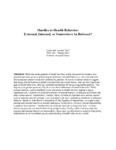| dc.rights.license | In Copyright | en_US |
| dc.creator | Lavette, Laura Elizabeth | |
| dc.date.accessioned | 2017-05-19T15:13:48Z | |
| dc.date.available | 2017-05-19T15:13:48Z | |
| dc.date.created | 2017 | |
| dc.identifier | WLURG38_Lavette_POV_2017_A | |
| dc.identifier.uri | http://hdl.handle.net/11021/33861 | |
| dc.description | Laura Elizabeth Lavette is a member of the Class of 2017 of Washington and Lee University. | en_US |
| dc.description | Capstone; [FULL-TEXT FREELY AVAILABLE ONLINE] | en_US |
| dc.description.abstract | While the social gradient of health has been widely discussed for decades, less attention has been given to quantifying the influence of health behaviors, which include both illness and preventative behaviors exhibited by patients. However, evidence seems to suggest that along with differences in health outcomes between social classes, there are also significant gaps in health behaviors, offering a potential mechanism for the growing health gradient. This begs an even greater question: why do we see these differences in health behaviors? While external barriers, such as healthcare costs and access to health services, appear to play a significant role, I explore the potential existence of internal barriers, or attitudes and beliefs that deter certain actions. Furthermore, Triandis' theory of behavior illustrates how internal factors, such as attitudes and self-concept, work in tandem with one's facilitating conditions to influence behavior. Based on John Rawls's conception of Fair Equality of Opportunity, we ought to treat internal and external barriers as morally analogous. Furthermore, we have a moral responsibility to address these barriers – whether they are external, internal, or complexly both – to more effectively promote our shared ideal of equal opportunity. Finally, while I acknowledge that external and internal barriers are inextricable, I show how my distinction is useful in both policy implications as well as enhancing our understanding of health behavior as a whole. | en_US |
| dc.description.statementofresponsibility | Laura Beth Lavette | |
| dc.format.extent | 36 pages | en_US |
| dc.language.iso | en_US | en_US |
| dc.rights | This material is made available for use in research, teaching, and private study, pursuant to U.S. Copyright law. The user assumes full responsibility for any use of the materials, including but not limited to, infringement of copyright and publication rights of reproduced materials. Any materials used should be fully credited with the source. | en_US |
| dc.rights.uri | http://rightsstatements.org/vocab/InC/1.0/ | en_US |
| dc.subject.other | Washington and Lee University, Shepherd Poverty Program | en_US |
| dc.title | Hurdles to Health Behavior: External, Internal, or Somewhere In Between? | en_US |
| dc.type | Text | en_US |
| dcterms.isPartOf | RG38 - Student Papers | |
| dc.rights.holder | Lavette, Laura Elizabeth | |
| dc.subject.fast | Health behavior | en_US |
| dc.subject.fast | Health attitudes | en_US |
| dc.subject.fast | Medical care | en_US |
| dc.subject.fast | Theory of justice (Rawls, John) | en_US |
| local.department | Shepherd Poverty Program | en_US |
| local.scholarshiptype | Capstone | en_US |
